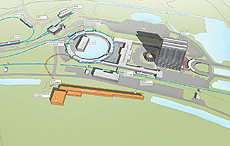PIP-II: Renewing Fermilab's accelerator complex
 |
The PIP-II accelerator will provide Fermilab with the high-power beams needed to carry out a world-class neutrino program. Image: Fermilab |
Even accelerator complexes can use some good, old-fashioned makeovers every now and then. The Proton Improvement Plan II, or PIP-II, is a proposed project to improve Fermilab's particle accelerator complex with a major hardware overhaul and a powerful boost in its capabilities.
"Every forefront research facility has to be continually renewing itself," said Steve Holmes, project manager for PIP-II. "Yesterday's performance is not going to be competitive tomorrow. We've done a lot with the Fermilab accelerator complex over the years, but eventually you reach a point where you've got to retire some of the really old stuff."
The headliner for this upgrade is neutrino physics, Holmes said. The next generation of neutrino programs is going to be bigger and more capable than current experiments. With more beam power, Holmes said, the physics reach will be substantial. When PIP-II achieves its design goal, it will deliver the world's most intense neutrino beam just in time for the Long-Baseline Neutrino Facility to start operations in 2025. The facility will support Fermilab's flagship research program, the Deep Underground Neutrino Experiment.
"We want high power to support our neutrino program," said Paul Derwent, deputy project manager. "That means lots of particles at high energy and frequently. To increase the power, we need to be able to increase the number of particles right from beginning."
PIP-II will allow physicists to accelerate more protons and help them achieve higher energy over a shorter distance. The project will involve retiring Fermilab's 400-MeV copper linac and building a new 800-MeV superconducting radio-frequency linac as well as replacing the beam transport to the Booster. There will also be upgrades to the laboratory's Booster, Main Injector and Recycler.
The most ambitious part of the PIP-II upgrade will be the new 800-MeV linear accelerator, which will be built in the infield of the decommissioned Tevatron accelerator and take advantage of significant existing accelerator infrastructure at Fermilab. The location will provide access to existing utilities, while allowing construction to proceed independent of ongoing accelerator operations and retaining possibilities for upgrade paths down the road. The linac design also provides an option for continuous-wave operations, which means delivery of an uninterrupted, rather than pulsed, stream of particles, providing physicists with more beam for other experiments, such as Mu2e.
A large part of this effort involves an international collaboration with India. The Department of Atomic Energy in India has offered to contribute hardware in exchange for the experience of building high-intensity superconducting radio-frequency proton linacs, which they hope to construct in their own country.
"I'm excited to have the chance to retire a bunch of accelerators that were old when I started here 30 years ago," Holmes joked. "But more seriously, what I find most attractive about this project is the opportunity to do something that will improve the performance of the Fermilab accelerator complex in a manner that will allow us to remain at the forefront both of accelerator-based neutrino physics and our other programs for decades."
—Ali Sundermier
|